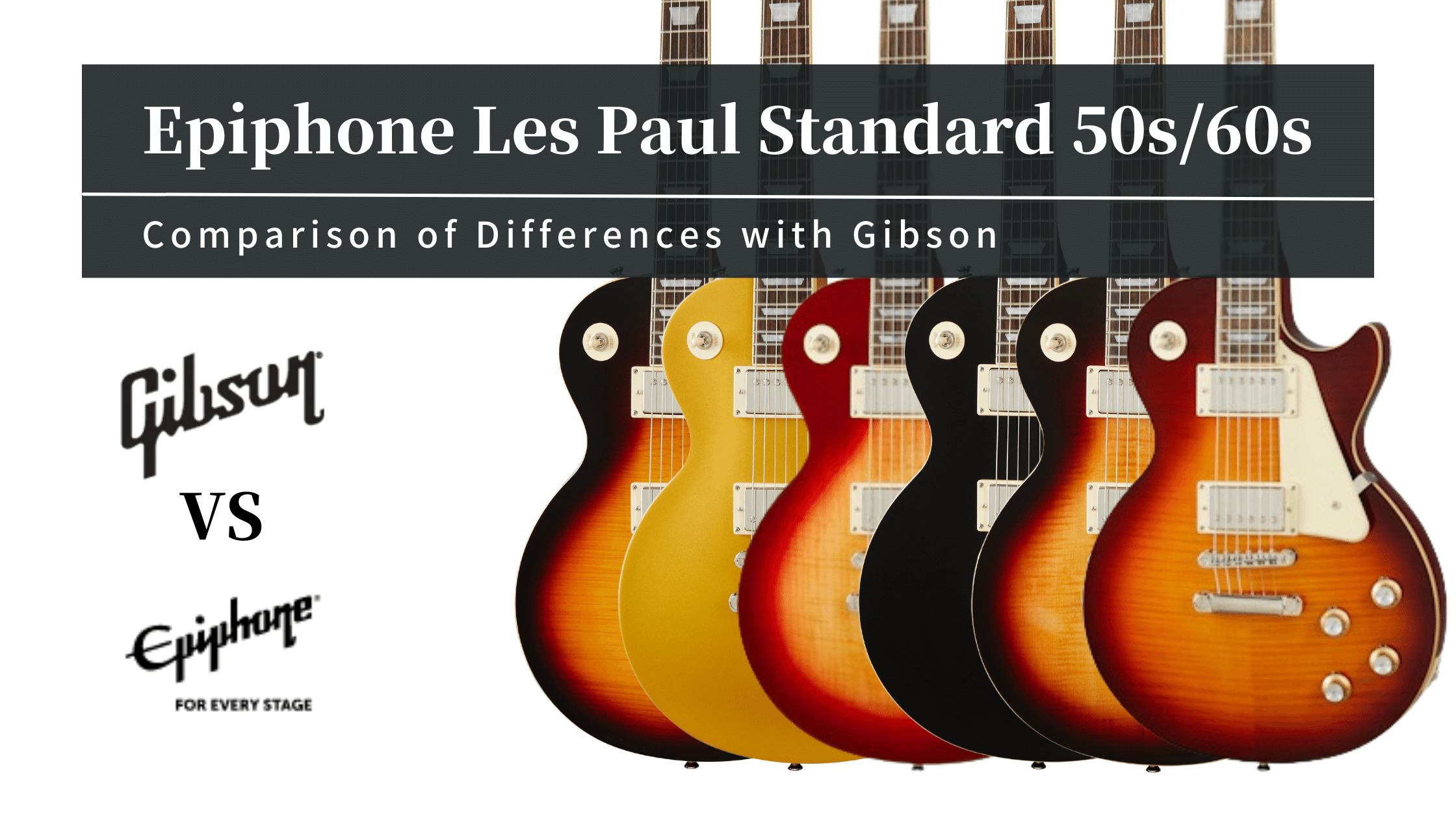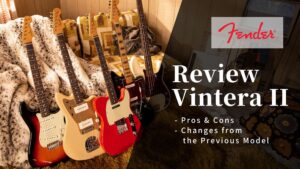Epiphone's Les Paul is one of the few affordable models that deliver. In terms of sound and playability, '50s model cater to vintage enthusiasts, while '60s model is clearer and modern. Gibson beats Epiphone in terms of aesthetics and playability. Gibson provides a sound preferred by advanced players. If it's your first or second guitar purchase, or if you're not too concerned about the brand and prioritize durability of the finish, you won't regret choosing Epiphone. If you have a larger budget, care about looks, and want to further enhance nuances in your playing, Gibson is the better choice.
- What’s the real deal with Epiphone Les Pauls?
- Is Gibson or Epiphone better?
- Will I regret buying an Epiphone?
- What’s the difference between the ’50s and ’60s models?
If these are the questions on your mind, Yosh (@Yosh_Guitar), an ex-music store staff member, is here with an unfiltered, in-depth review.
About Epiphone
Epiphone is currently recognized as a subsidiary brand under Gibson. However, it was originally established back in 1873. It developed various original models and was used by a large number of artists, including The Beatles. After being acquired by Gibson in 1957, Epiphone started to release budget models of Gibson’s guitars. Nowadays, it continues to manufacture affordable guitars while maintaining quality at its own factory in China. While the latest machinery is used, many processes are done manually in order to ensure higher quality.
Pros
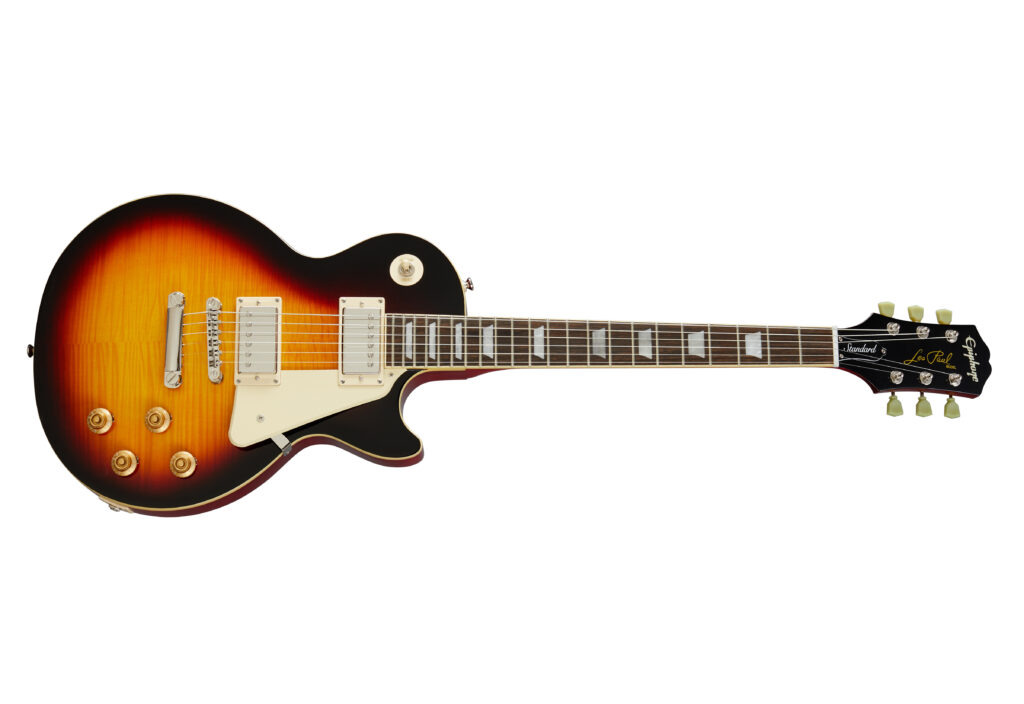
- Genuine Les Paul
- One of the few Les Paul models at a price beginners can afford
- Classic Les Paul sound
Genuine Les Paul
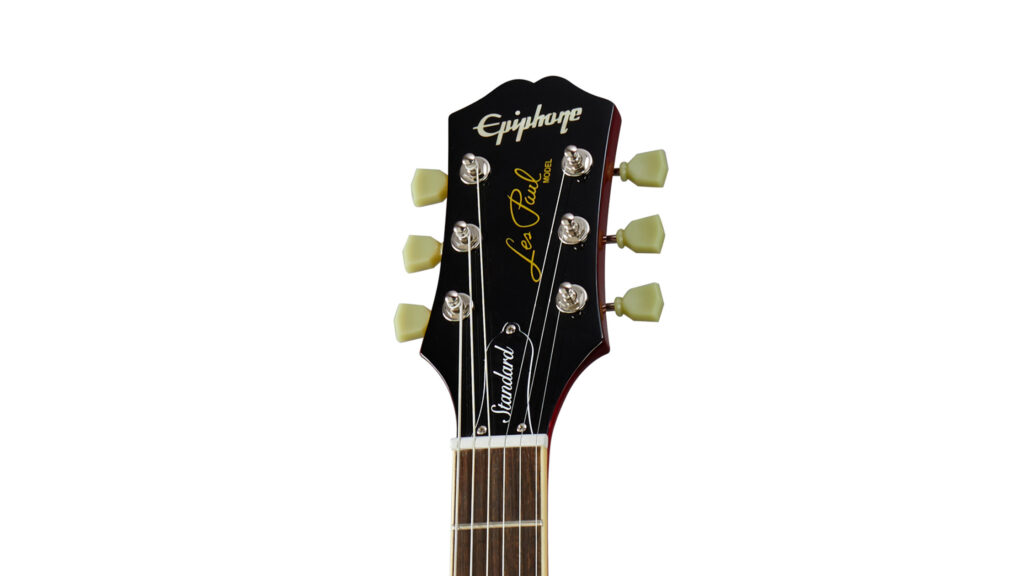
Epiphone is the only brand currently allowed to use the Les Paul name, apart from Gibson. “Les Paul” is a registered trademark of Gibson. Therefore, no other brands produce a guitar called “Les Paul”. Since Epiphone is a brand under Gibson, it is recognized as a genuine Les Paul.
One of the Few Les Pauls Affordable for Beginners
In the current market, there are few inexpensive Les Paul-type guitars. This is due to the complex manufacturing processes involved, such as the set-neck construction and the arched top body. However, Epiphone’s Les Paul Standard is produced in accordance with Gibson’s quality standards in a dedicated factory, which makes it well balanced in terms of price and quality. If a beginner is looking for a Les Paul-type guitar, the Epiphone Les Paul Standard is definitely one of the options to consider.
Classic Les Paul Sound
With the Les Paul Standard, even from Epiphone, you can expect a rich and abundant sound directly descended from Gibson Les Pauls. This sound is produced by the Les Paul’s mahogany body, set-neck construction, and humbucker pickups. Humbucker pickups have less noise compared to single-coil pickups and output a fatter and more powerful sound. As a result, the Epiphone Les Paul Standard is perfect for genres requiring a rich and abundant sound, such as rock, blues, punk, melodic hardcore, hard rock, and metal that need thick distortion.
Cons
- Playability appropriate for its price
- Headstock shape differs from Gibson
- Lacks a premium look
- Some parts are not interchangeable
Playability Appropriate for Its Price
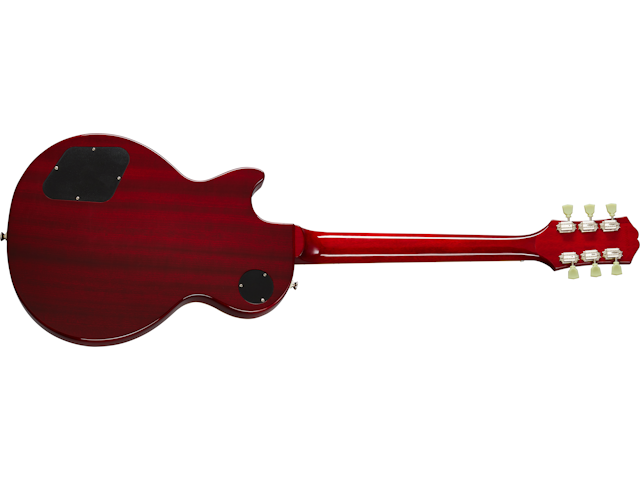
Compared to Gibson or Japanese-made guitars that are more expensive than Epiphone, there is a limit to the adjustability of the playability. This is due to the lower precision compared to high-priced guitars. Therefore, even with adjustments to the neck and bridge, the Epiphone has slightly inferior playability compared to Gibson.
However, rest assured that it doesn’t have the poor quality often found in cheap guitars, such as uncomfortable neck grip or snags. In addition, it features larger medium-jumbo sized frets, so your fretting hand can press down on the strings with less force. In other words, while it might be inferior to Gibson in terms of playability, it is by no means difficult to play.
Headstock Shape Differs from Gibson
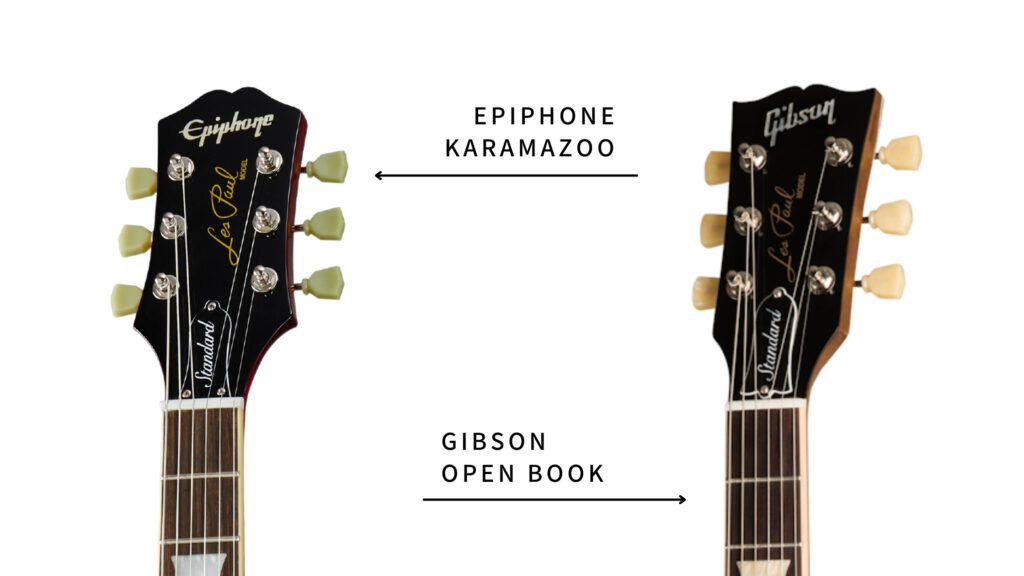
The shape of the headstock is not exactly the same as Gibson’s. Gibson’s Les Paul headstock has a shape called the “open book” type. On the other hand, the headstock of Epiphone’s Les Paul changed to a new shape called the “Kalamazoo head” in 2020. This new design is closer to Gibson’s and has received positive reviews from users.
Lacks a Premium Look
Compared to Gibson, Epiphone lacks a high-end look due to differences in finish and wood quality. If you’re a guitar enthusiast, you may notice the difference in appearance. Epiphone uses a polyurethane-based finish that has a glossy, shiny texture when lit. While it has the advantage of being highly durable with very little aging, it slightly lacks a high-end feel. Also, to keep the price down, different types of wood with different colors and grain patterns are used compared to high-end guitars.
Some Parts are Not Interchangeable
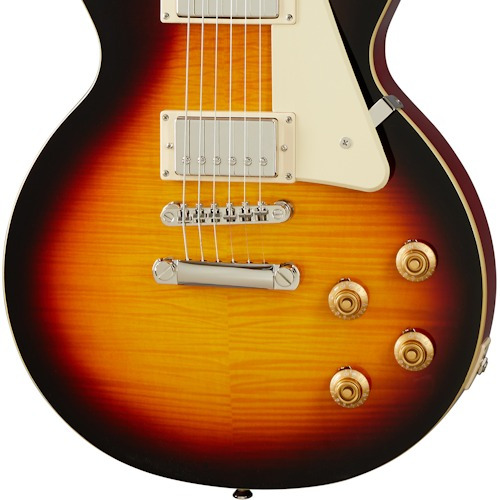
Some parts of the Epiphone follow a specific Epiphone standard and cannot be replaced with aftermarket parts. Also, it seems that the specifications of the parts may change without notice. Specifically, it appears that parts like the bridge and pickguard often cannot be directly replaced. There may be cases where parts cannot be replaced when they break or when you want to upgrade and modify your guitar. However, there’s no problem with replacing pickups, machine-head or potentiometers.
Specifications
- Body: Maple Top + Mahogany Back
- Neck: Mahogany
- Neck Joint: Set Neck
- Fingerboard: Indian Laurel
- Scale: 628mm
- Fingerboard Radius: 305mm
- Frets: 22, Medium Jumbo
- Nut: 43mm, Graph Tech
- Bridge: Epiphone LockTone Tune-O-Matic
- Controls: 2-Volume, 2-Tone, CTS Pots
- Pickup Selector: Epiphone
These are the basic specifications of the Epiphone Les Paul Standard. It follows the traditional Les Paul design with a maple and mahogany body, and a mahogany neck joined with a set neck. The fingerboard is made of Indian Laurel instead of Rosewood. The color and texture are very similar to Rosewood, and at first glance, you won’t see much difference from cheaper Rosewood.
The scale and fingerboard radius, which greatly affect playability, also follow the traditional Les Paul specifications. It’s also great that they use larger medium-jumbo frets, which makes it easier to press down on the strings. In addition, the pots for volume and tone are made by CTS, the same as Gibson. This is a significant feature that helps to ensure a high-quality sound.
Defference 50s vs 60s
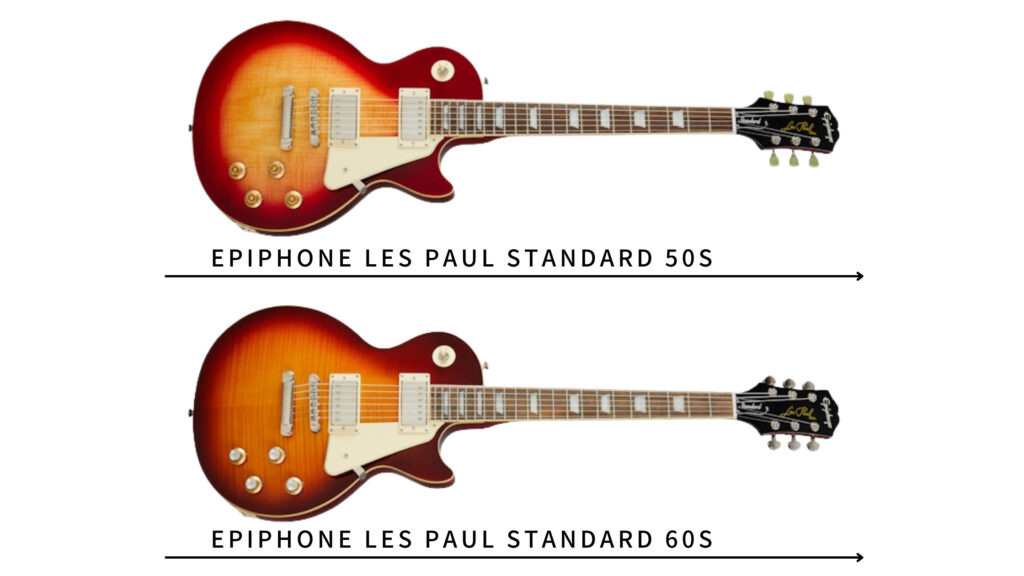
| Item | 50s | 60s |
|---|---|---|
| Market Price | $699 | $699 |
| Body Top | AAA Flame Maple Veneer + Maple | AA Flame Maple |
| Color | Metallic Gold, Vintage Sunburst, Heritage Cherry Sunburst | Ebony, Bourbon Burst, Iced Tea |
| Knob | Gold Top Hat | Gold Reflector Knob with Silver Insert |
| Neck Shape | 50s Rounded Medium C | Slim Taper 60s C |
| Pickup | Probucker 1, Probucker 2 | Probucker 2, Probucker 3 |
| Peg | Epiphone Vintage Deluxe | Grover Rotomatic |
| Sound Characteristics | Calm, Thick Sound | Clear Sound with Sustain |
Differences in Appearance: Body Top and Color
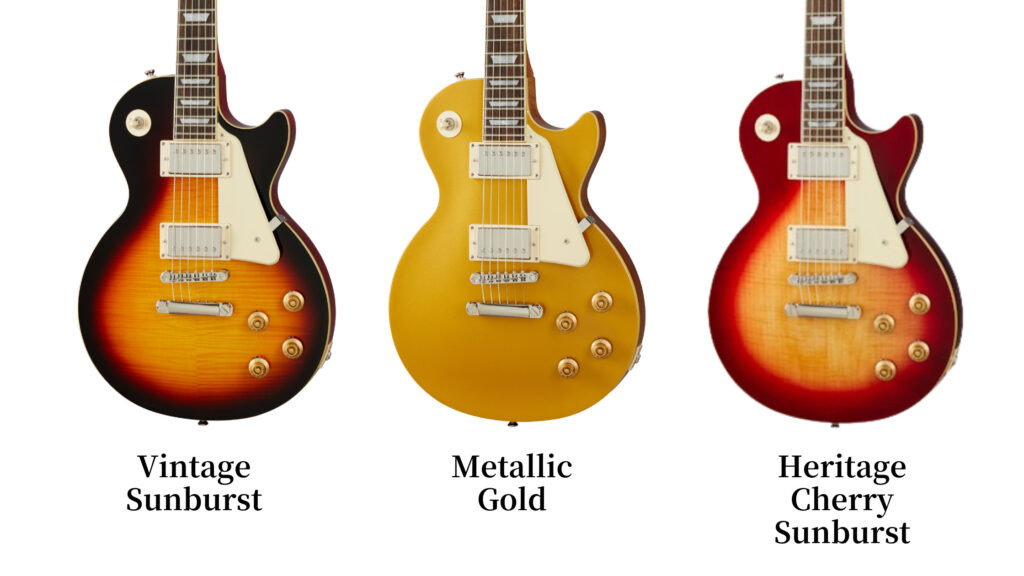
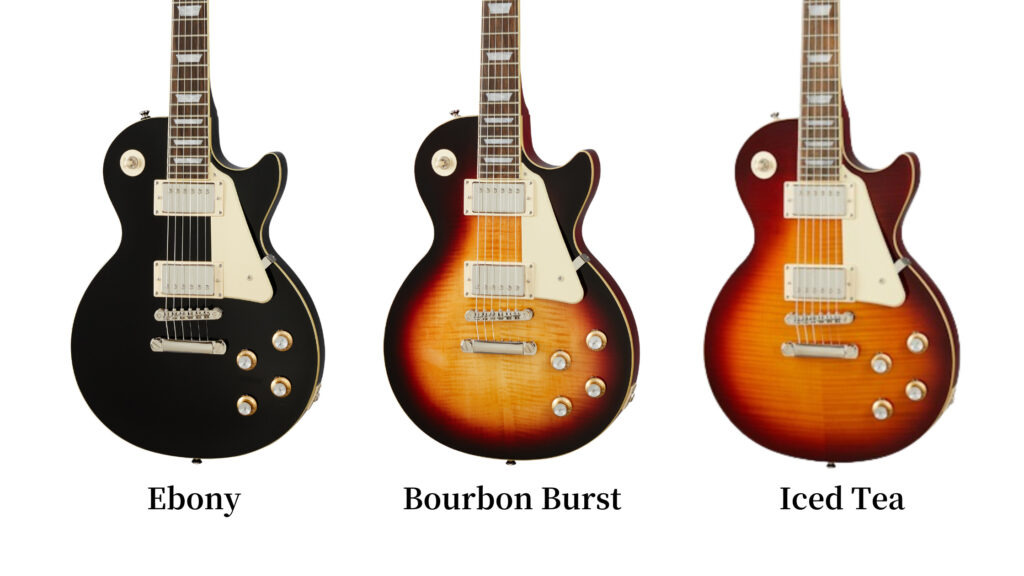
The appearance of the body top varies due to the grain and color of the wood. For the 50s model, the wood grain is usually AAA grade, displaying a distinct flame pattern. However, as it’s made from veneer plywood, the grain doesn’t change much with different viewing angles and lacks depth. The pattern comes from the actual wood, but it’s just a very thin veneer sheet that’s been applied. Nevertheless, the veneer, laid on top of the maple and mahogany, doesn’t affect the guitar’s sound characteristics. It’s also important to note that there can be individual differences in wood grain. Even in the 50s model, some guitars may not have a flamboyant grain.
On the other hand, the 60s model is AA grade, with less pronounced grain and is not made from veneer. While this means there’s more variability between individual guitars, some models may change their look from different viewing angles.
The color of each model varies, and there are no identical colors. However, burst colors in both brown and red tones tend to appear similar. Additionally, the volume and tone control knobs for each model are designed based on what was used in their respective eras.
Differences in Playability: The Neck of the 50s is Thick, 60s is Somewhat Thin
The 50s model features a thicker neck shape, emblematic of the Les Paul style. It’s ideal for players who grip the neck tightly and perfect for traditional genres such as blues and classic rock.
The 60s model has a comparatively thinner neck shape. It’s great for players who want a lighter touch for fast licks and arpeggios. This model is geared towards genres like hard rock, metal, and fusion. Both models have larger frets, making them easier to play than typical beginner guitars.
Differences in Sound: 50s is Fat, 60s is Clear
With different pickups, neck shapes, and tuning pegs, the two models deliver the quintessential Les Paul sound but with slight variations.
To summarize the differences in sound:
- 50s: A warm tone with an emphasized midrange. Due to the lower output of the pickups, the sound leans towards a vintage tone that clearly expresses the articulation of your playing.
- 60s: A clear and tight tone with a slightly emphasized treble. This model handles everything from overdrive to distortion well, making for a sound that’s well-suited for rock.
The power of the pickups increases as the number following “ProBucker” gets larger. Moreover, a thicker neck tends to push out the midrange, while a thinner one trims the midrange and makes the treble more audible. While it may not get much attention, the tuning pegs significantly alter the sound. Specifically, the heavier 60s Grover tends to offer longer sustain and a straighter sound.
50s for Blues and Vintage Lovers, 60s for Rock and Beginners
The Epiphone Les Paul Standard 50s offers a warm tone and vintage-style Les Paul that enables nuanced play. The Epiphone Les Paul Standard 60s, on the other hand, provides a clear, tight tone with a good distortion match for rock enthusiasts. With a C-shaped neck that’s not too different from a typical guitar, the 60s model is recommended for most users, especially beginners. If you prefer a thick neck, then the 50s model is for you. It’s not excessively thick, so if you prefer the sound and appearance of the 50s model, you should be able to get used to it with some playing time.
Differences with Gibson: Personal Impressions from a Hands-on Comparison
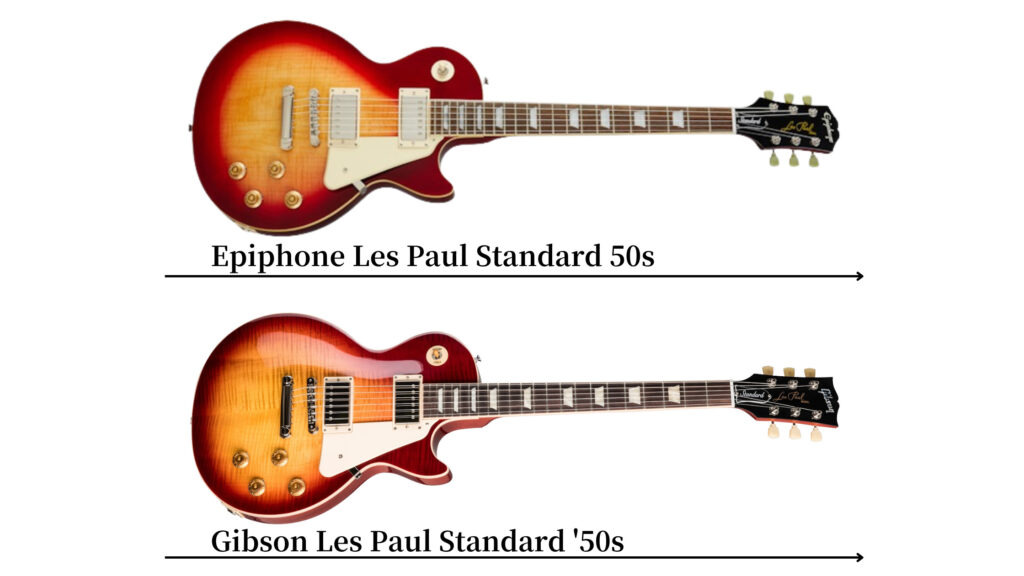
| Item | Gibson Les Paul Standard 50s | Epiphone Les Paul Standard 50s |
|---|---|---|
| Market Price | $2,999 | $699 |
| Body Top | Maple | AAA Flame Maple Veneer + Maple |
| Body Back | Mahogany | Mahogany |
| Neck Material | Mahogany | Mahogany |
| Fretboard Material | Rosewood | Indian Laurel |
| Fretboard Radius | 12 inch (305mm) | 12 inch (305mm) |
| Neck Shape | Vintage 50s | 50s Rounded Medium C |
| Scale | 24.75 inch (628mm) | 24.75 inch (628mm) |
| Nut Width | 1.695 inch (43mm) | 1.692 inch (43mm) |
| Nut | Graph Tech | Graph Tech NuBone |
| Number of Frets | 22, Medium Jumbo | 22, Medium Jumbo |
| Inlay | Acrylic Trapezoid | Trapezoid |
| Pickup | Burstbucker 1 & 2 | Probucker 1 & 2 |
| Control | 2 Volume, 2 Tone, Toggle Switch (with Orange Drop Capacitors) | 2 Volume, 2 Tone, Toggle Switch |
| Bridge & Tailpiece | ABR-1 Tune-O-Matic & Aluminium Stop Bar | Epiphone LockTone Tune-O-Matic & Stop Bar |
| Tuners | Gibson Deluxe | Epiphone Vintage Deluxe |
| Finish | Gloss Nitrocellulose Lacquer | Gloss Poly |
| Case & Accessories | Hard Shell Case, Gibson Accessory Kit | Epiphone Soft Case |
Visual Differences: Subtle Differences for the Aficionado
While both guitars bear the official Les Paul moniker, they are not entirely identical. From the types of wood grade and parts used, to the finish work, headstock, body shape and even the curvature, the minute details vary.
- Top Material: Gibson uses solid figured maple, which has depth and changes in appearance depending on the viewing angle. However, there’s considerable individual variation and it doesn’t typically have flashy grains. Epiphone uses a figured maple veneer, which gives every piece a distinct flair.
- Fretboard Material: Epiphone’s Indian laurel doesn’t look too different from traditional, cheaper rosewood. However, when compared to Gibson’s rosewood, it appears slightly brighter and less saturated.
- Finish: Gibson uses a glossy nitrocellulose lacquer finish, which requires careful maintenance. Epiphone opts for a more durable polyurethane finish, which can feel a bit plasticky compared to lacquer.
- Headstock Shape: Gibson uses an open book shape, while Epiphone employs the Kalamazoo headstock.
- Other: Subtle differences exist in areas like body curvature and the shape of the parts.
At first glance, both guitars appear to be Les Pauls, but from an enthusiast’s perspective, there are discernible differences even without looking at the headstock.
Playability Differences: Gibson Offers a More Stress-free Experience
While Epiphone is by no means difficult to play, Gibson offers a more stress-free performance. Gibson has superior parts quality, greater precision, and wider adjustment options. I personally prefer slightly lower string action, and simply straightening the neck and lowering the bridge achieves a stress-free setting with Gibson. The same adjustments on Epiphone did not yield the same feel. However, there were no quality issues such as painful fret edge.
Sound Differences: Gibson is Delicate, Epiphone is Straightforward
Both offer the quintessential Les Paul sound, but differences in pickups, woods, and other factors create distinct characteristics. Gibson offers richer harmonics and a wider dynamic range, with high resolution. The detailed nuances in the player’s performance, such as picking strength, are well-articulated, indicating superior expressiveness.
Epiphone also delivers a characteristic rich Les Paul sound, but lacks the delicacy of Gibson, instead producing a more straightforward sound. Beginners might find it easier to sound.
Compare Gibson and Epiphone Les Pauls in the following video.
In a blindfold test, it’s not always easy to guess which is Epiphone. It’s not fair to say Epiphone’s sound quality is inferior to Gibson’s; it’s more accurate to say they have different characters.
Why Epiphone is Cheaper than Gibson
There’s a considerable price difference between Epiphone (around $699) and Gibson (around $2,999), almost a factor of four.
- Manufacturing Cost: The location of the production facilities directly affects labor costs. The U.S., in particular, is experiencing severe inflation, leading to rising labor costs.
- Finish: Gibson’s lacquer finish takes more time to dry and cure, making it more expensive. Epiphone’s polyurethane finish is more suited to mass production, reducing the price.
- Wood: Epiphone keeps costs down by not using highly figured maple for the body top and by opting for different materials for the fretboard instead of rosewood.
- Parts: Epiphone uses its own parts, such as bridges and pickups.
By reducing the time spent on manufacturing each guitar and lowering the cost of materials and parts, Epiphone manages to maintain a lower price point. As a result, there are differences in playability and sound, but given its set-neck construction, the quality and performance of Epiphone are exceptional for its price range, making it suitable for beginners and intermediate players.
My Personal Impressions After Comparing Both
Personally, playing the Gibson is more enjoyable. Being able to lower the string action to a certain extent and play without stress at any position, and the depth and high resolution when played at a larger volume, feels good. As for Epiphone, it’s not that it’s particularly good value for money, rather it gives an impression of being worth its price. Since I usually play USA-made PRS or Gibson Flying V, when compared to these, I don’t find the Epiphone as comfortable.
However, the set-neck construction at this price point is quite exceptional. With proper adjustment, it’s good enough to be used in a band performance without any complaints.
You should consider buying a Gibson if you:
- Plan to use it carefully for 10 years or more
- Want to improve further
- Want to practice articulation and subtleties carefully
- Want to satisfy your desire for ownership with a Gibson headstock
- Want to enjoy the finish, wood, and details just by looking at it
- Want to sell it at a decent price when you let it go
- Are using a guitar that costs less than $1,000 and have complaints about it
On the other hand, you won’t regret buying an Epiphone if you:
- Are a beginner guitarist
- Are buying your first or second guitar
- Mainly practice at home or in lessons
- Don’t have a budget of $1,000 for buying a guitar
- Plan to buy a guitar costing more than $2,000 a few years later
- Are worried about maintaining a lacquer finish
- Usually use a Fender-style guitar and are looking for a Les Paul as a second guitar
- Don’t place much importance on brand or details
Summary: The 60s Model is Recommended for Most People
The Epiphone Les Paul Standard 50s has a thicker neck feel and a tone influenced by lower-output pickups, making it a specification that professionals would prefer. Lately, I get the impression that people who prefer this specification are mostly advanced players, in which case, they might not be satisfied with anything other than a Gibson. For people who are budget conscious and like this kind of mature feel, there is not any other choice among other brands.
The Epiphone Les Paul Standard 50s is recommended for people who:
- Want a warm, resonant tone
- Enjoy blues and classic rock
- Want to challenge themselves with a slightly thicker, rounder neck
- Prefer traditional peg looks
The Epiphone Les Paul Standard 60s, with its general neck thickness for playability and balanced pickup tones, is designed to be easy to play for most people. It’s perfect for those who want a classic Les Paul on a low budget.
The Epiphone Les Paul Standard 60s is recommended for people who:
- Are electric guitar beginners
- Prefer a clear, tight, easy-to-play sound
- Enjoy rock, pop, melodic hardcore, metal, etc.
- Feel safer with a neck of regular thickness
- Want to practice fast playing

